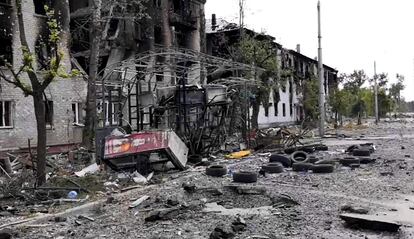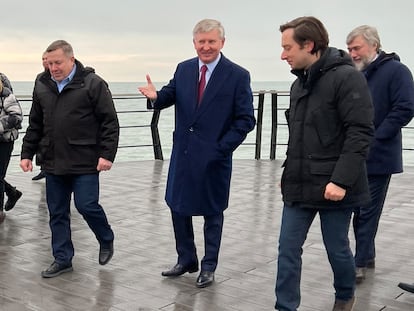Russia says it has taken Lysychansk, key city in battle for eastern Ukraine
Ukrainian President Volodymyr Zelenskiy said in a televised address that the retreat was meant to save lives, but insisted there were still pockets of resistance

With a brief statement and without the rhetoric of past victories, the Russian army claimed to have fulfilled one of its two territorial objectives in Ukraine: control over the Luhansk region in the east. After 130 days of fighting, Russian Defense Minister Sergei Shoigu informed President Vladimir Putin on Sunday that Lysychansk, the last major city still under Ukrainian control in the area, is now in Russian hands.
Ukraine’s army announced on Sunday that it had been “forced to withdraw” from the critical city. President Volodymyr Zelenskiy said in a televised address that the retreat was meant to save the lives of Ukrainian troops, although he also claimed that the city was not completely in Russian hands yet and that there were pockets of resistance.
Together, Luhansk and Donetsk make up the larger Donbas region, which Putin is seeking to bring entirely under his control. With Sunday’s victory, he is closer to that goal.
The spokesman for the Ukrainian Ministry of Defense said that even though Russia has taken control of the entire Luhansk area, the battle for the larger Donbas region “is not over,” since there are still cities in Donetsk in Ukrainian hands.
On February 21, three days before starting his offensive against Ukraine, Vladimir Putin signed two decrees that recognized the two self-proclaimed republics of Lugansk and Donetsk as independent countries, something that not even other close allies of Moscow such as Kazakhstan have done. The Russian president later clarified that the borders would match those drawn by the separatists in May 2014 in two illegal referendums. This included the territory that the Ukrainian government managed to keep until 2015, a year after the start of the conflict in the area between Ukraine and Russian-backed separatists.
On the eastern front, Ukrainian troops are facing an intense artillery offensive in residential areas. In recent weeks, Moscow has intensified missile attacks in areas far from the war front, hitting civilian targets. Volodymyr Zelenskiy’s government has accused Russia of state terrorism.
Ukrainian military expert Mikhailo Samus downplayed the capture of Lysychansk. “Already at the beginning of the war, Putin said that he had ‘liberated’ the entire Luhansk province. But it has taken four months to complete the operation,” he said in a telephone conversation. Samus further argues that, from a global perspective, the key in the war now for Ukraine is to seize back southern cities like Kherson and Melitopol from Russian hands. And the fact that all Russian forces are concentrating on the battle in the east gives Kyiv’s troops more chances to advance south.
Samus believes that the Russian strategy of attacking civilian targets of no military interest, such as a shopping center in Kremenchuk on Monday, reflects the Kremlin’s will to increase psychological pressure on the Ukrainian population and lower their morale. “Of course the loss of human lives is a tragedy, but Putin only wants us to become demoralized and for Ukrainians to think that we are facing an enemy that is too powerful, and that it would be better to surrender,” he concludes.
Putin concerned about his own casualties
The Kremlin has claimed to have different objectives in Ukraine throughout these four months of fighting. Putin first announced “the demilitarization and de-nazification” of the country as goals. Later, after abandoning the fight for Kyiv in March, he reiterated that the incursion was a “special military operation for the defense of the people’s republics of Donetsk and Luhansk.”
Leonid Pashenchik, leader of the Luhansk secessionists, welcomed the Russian advance. “Ukrainian neo-Nazis who came to our land to kill and steal were defeated!” he said in usual rhetoric about a territory that Russia has recognized as Ukrainian for more than three decades.
On June 29, Putin admitted that the advance of his troops in the east is taking place more cautiously to avoid a higher number of casualties. In these four months, the Russian Ministry of Defense has only announced an official number of casualties twice, the last one on March 25, when it claimed to have registered 1,351 dead and 3,825 wounded among its troops until then. However, the figures estimated by the Ukrainian government and NATO countries are much higher.
Tu suscripción se está usando en otro dispositivo
¿Quieres añadir otro usuario a tu suscripción?
Si continúas leyendo en este dispositivo, no se podrá leer en el otro.
FlechaTu suscripción se está usando en otro dispositivo y solo puedes acceder a EL PAÍS desde un dispositivo a la vez.
Si quieres compartir tu cuenta, cambia tu suscripción a la modalidad Premium, así podrás añadir otro usuario. Cada uno accederá con su propia cuenta de email, lo que os permitirá personalizar vuestra experiencia en EL PAÍS.
¿Tienes una suscripción de empresa? Accede aquí para contratar más cuentas.
En el caso de no saber quién está usando tu cuenta, te recomendamos cambiar tu contraseña aquí.
Si decides continuar compartiendo tu cuenta, este mensaje se mostrará en tu dispositivo y en el de la otra persona que está usando tu cuenta de forma indefinida, afectando a tu experiencia de lectura. Puedes consultar aquí los términos y condiciones de la suscripción digital.
More information
Últimas noticias
Chris Martin, Taylor Swift, Elijah Wood and other famous wedding ‘crashers’
‘How does it feel to be a failure?’: Elizabeth Berkley’s journey from ‘Showgirls’ ridicule to vindication
The story of the Málaga virus: The code that haunted Google’s cybersecurity center director for 30 years
The impact of Ecuador’s mega-prison: A polluted river, cleared forests and military checkpoints
Most viewed
- Christian Louboutin: ‘Young people don’t want to be like their parents. And if their parents wear sneakers, they’re going to look for something else’
- The low-cost creative revolution: How technology is making art accessible to everyone
- Liset Menéndez de la Prida, neuroscientist: ‘It’s not normal to constantly seek pleasure; it’s important to be bored, to be calm’
- All the effects of gentrification in one corner of Mexico’s Colonia Roma
- December Social Security and SSI payments: Dates, double checks and the 2026 COLA increase










































